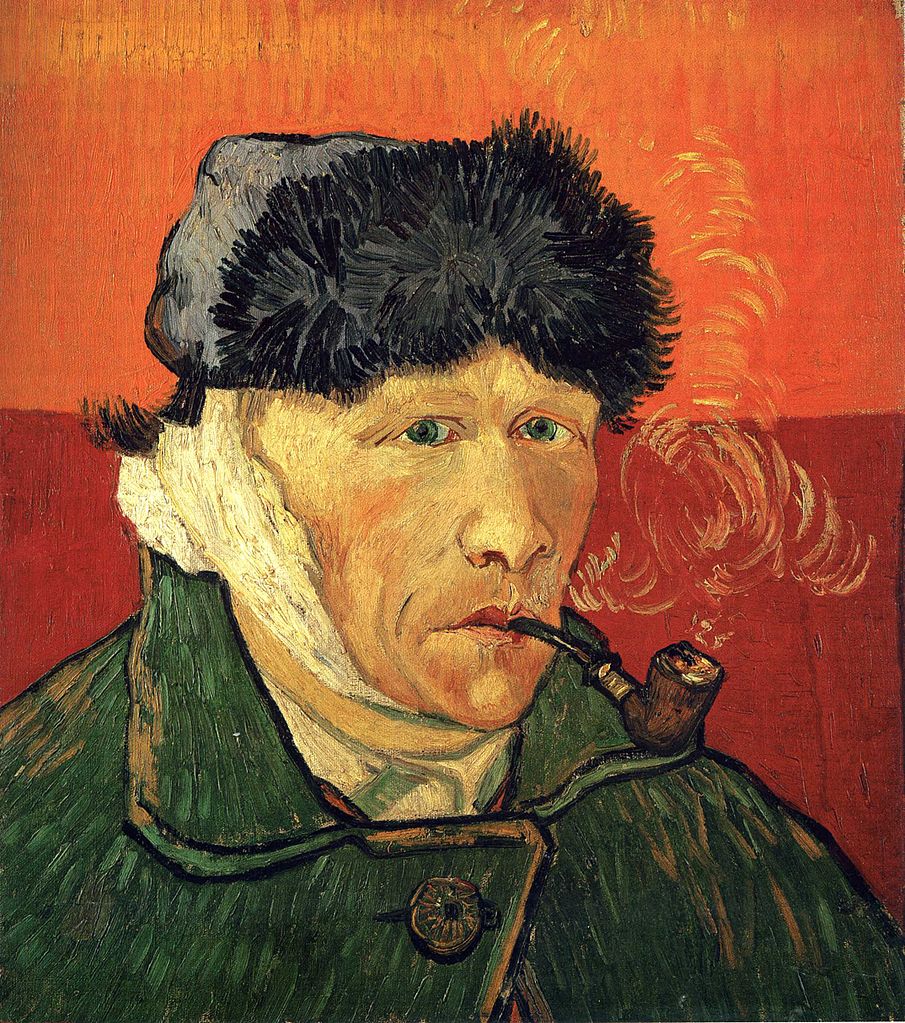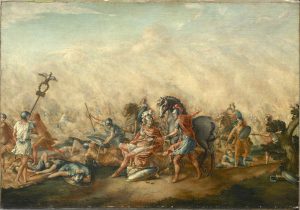Vincent Van Gogh was an admired artist, who was also a troubled and “tortured genius.” His artwork, Starry Night, Bedroom in Arles, and many others have earned him fame and recognition as one of the greatest artists of his time. But what many remember most about this artist is the story of his severed ear. Although his art is exemplary, his struggle with mental health and self-harm is admirable. His struggle was overlooked due to his incredible talent. He was successful as an art dealer, but as an artist, he had to prove himself with the headquarters of international art dealers, Gopil & Cie. During his lifetime, Van Gogh was the poster boy for the image of starving artist. His artwork was not recognized until much later in his career, which could have been a leading cause of his major depression and anxiety.1
Van Gogh, born in the Netherlands, decided to start his career in Paris in the 1880s, where many of the age’s great artists also resided. He believed he could get recognition for his pieces through his younger brother, Theo, who made his living as an art dealer. His brother introduced him to many artists, including Georges Seaurat, Camille Pisatto, and Paul Gauguin. Upon meeting these successful artists, Van Gogh was greatly inspired by their work and began creating his own artistic style, beginning in 1883. Later the same year, Van Gogh rented a small house in Arles, in the south of France. Paul Gauguin and Van Gogh became close friends and later roommates. They consistently bounced ideas off of each other and created a strong friendship.2

Like many friendships, theirs was rocky, and they found themselves drifting apart. Gauguin had moved on to a different artistic style and was exploring other ideas. Van Gogh at the time, had been reciprocating signs of depression and mental health issues, but at the time, these symptoms were considered normal. When Gauguin decided to explore other art spectrums, it involved moving out of the house he and Van Gogh shared. He broke the news to his roommate about his intentions, and this evidently this made Van Gogh go over the edge. He did not take the news lightly and both men began verbally arguing. Van Gogh had disappeared for a few hours and when he returned to confront Gauguin, he had a razor blade in hand threatening to hurt Gauguin.3
During the confrontation, however, Van Gogh was hesitant to hurt his friend and decided to turn the blade on himself and completely cut off his ear. Gauguin left him bleeding and alone. Van Gogh bandaged his head and began drowning himself in alcohol. During this episode, he walked out of his home and into the streets where he found a prostitute. The ear that he had severed off of himself had been neatly wrapped in a cloth; since Van Gogh was still heavily intoxicated, he decided to present this token to the prostitute. Patiently, she ran off and alerted the police about her encounter and they immediately rushed to his home.4
Shortly before Christmas Eve, Van Gogh was found by police in his bed, partially conscious and with major blood loss. Authorities rushed him to the hospital where he surprisingly recovered. Meanwhile, Gauguin was brought into questioning, but gave no testimony on the incident. It was believed that Van Gogh had suffered a severe mental breakdown long before he had severed his ear, but that this created a ripple effect that led to lunacy. The real reason behind the infamous Van Gogh ear-cutting may never be known; Gauguin had promised Van Gogh a pact of silence on the situation in letters that they supposedly exchanged. 5

After the incident, Van Gogh was admitted into a psychiatric facility in hopes of recovering mentally and physically. The dramatic change was not helpful for such a troubled artist, and in July of 1890, Vincent Van Gogh ended his life with a revolver. Before his suicide, however, he created a very iconic painting, Self Portrait with Bandaged Ear 1889. Van Gogh intended to persuade his doctors that he was perfectly able to continue working and creating art by creating this self portrait. He presented his piece, leaving a trail of wonder for his supporters as to why he included certain details in this particular piece, mainly because he continued to paint himself in the same yellow house he and Gauguin shared. Doctors overlooked these details and allowed Van Gogh to leave the facility.6
The epidemy of many artists like Van Gogh is often associated with mental instability, drug use, and alcohol abuse. Van Gogh had an array of medical issues that were tied back to his coping mechanisms (alcohol abuse), and as a result, many did not understand the struggles he faced and degraded him as a person while idolizing his artistic talent. As said before, the real reason behind his mutilated ear will be unclear, but his work and talent will continue to inspire and educate.
- Adam Gopnik, “Van Gogh’s Ear,” The New Yorker, Literature Resource Center (January 4, 2010): 48. ↵
- “Who Really Cut Off Van Gogh’s Ear?” Weekend All Things Considered, Literature Resource Center, (May 2010). ↵
- “Who Really Cut Off Van Gogh’s Ear?” Weekend All Things Considered, Literature Resource Center, (May 2010). ↵
- Belinda Thomson, “Comparing lives: issues of balance in biographical writing,” Literature Resource Center, French Politics, Culture and Society 24, no. 2 (2006): 60. ↵
- Tim Suermondt, “All the Answers.” Literature Resource Ceter, Prairie Schooner 85, no.3 (2011): 47. ↵
- Tim Suermondt, “All the Answers,” Literature Resource Center, Prairie Schooner 85, no. 3 (2011): 47. ↵



170 comments
Nathan Hudson
It was so interesting to read about how he had mental issues. I had no idea why he cut off his ear, but now it seems that he was having issues. I enjoyed reading about how he became an artist and the way that you lead to why he removed his ear was very well-written. I so not know very much about artist or paintings, so reading about something new was very interesting.
Erin Vento
I feel like everything concerning Van Gogh is so romanticized because we think we know his story, but after reading your article, I know that’s not the case. He was a real human and he was obviously depressed and not mentally well, and while it’s hard to forget about the life we thought he had (that he was just sad and that he cut off his ear for the woman he loved), he would get mad and perhaps wasn’t safe to be around. His art is spectacular and should have been recognized when he was alive, but this article shows that behind the mysticism of Van Gogh there was a really hurt person.
Christopher Sanchez
I love Van Gogh work and knew somewhat of his history but reading this article provided better insight into his life. He was one of the best artist in his generation but didn’t get any recognition until later in his career. I always wondered why he caught of his ear then paint a portrait of himself. It was bizarre, but artists tend to do things out of the norm, he had a different view of art that we still can’t figure out.
Jason Garcia
I was taught that Van Gogh cut his ear off and gave it to a girlfriend of his as a symbol of his love, Which should’ve told me that he had mental problems but for whatever reason, I never knew he suffered. I not really one to appreciate art as much as other people could be, but I always thought he was a great artist. Van Gogh may have been a great painter but this doesn’t make up for his mental illnesses and problems. His story is another one that proves that even a person that may seem like the happiest person in the world can actually be the saddest.
Arianna Kennet
Everyone knows Van Gogh but how many people actually know his story is another question because before reading this article, the only thing I knew about him besides the fact that he was a painter was that he was suffering from a mental illness. I did not know the whole history behind it, and I just realized how gruesome it was. What an interesting episode that was, from how he cut off his ear to presenting it as a token to a prostitute, you don’t see that happening everyday.
Maricela Guerra
I never did know Van Gogh did cut off his ear until now, I also didn’t know that there was this battle between these two friends just before the incident of the severed ear. Even though Gogh was a great artist, I wonder what did actually made him a little insane in the brain that lead him to take his own life. I would have figured that being such a famous painter would have it’s benefits.
Natalie Childs
I, as most people I am sure, had heard of Van Gough before this article and knew of his work. Though, with that said, I knew absolutely nothing of his back story or his life other than his work and that at some point or another he had cut his own ear off. The author does a great job of painting the story of Van Gough and really makes him out as the sympathy character that he is, considering the mental instability, and the like.
Jose Figueroa
I was first introduced to Van Gogh in middle through a song about his Starry Night painting. His art style is breath taking and captivating. I knew the story about his cut off eat but did not know an argument with his best friend was what lead to it. Just like anyone else he had his fair share of mental battles but was still able to captivate beauty.
Luis Morales
I always knew Van Gogh battle mental illness, but never to the full extent. It was interesting to learn that Van Gogh’s artwork was not recognized until much later in his career, which probably was the leading cause of his major depression and anxiety. I have always been a fan of Van Gogh’s work, his style of art, and the fact that he battle a severe mental illness.
Anna Guaderrama
I always knew that Van Gogh had his own battle with mental illness. And although nowadays it’s cool to talk about how he supposedly ate yellow paint in attempts to become happy (mainly tumblr users), it’s sad to glorify such a deadly and deteriorating disease for likes and trying to be relatable to an online audience. I’ve always admired Van Gogh for his style of art and the struggle he dealt within himself, it’s sad but I feel like some of the most talented and artistic people tend to be the saddest, it shows in their work – no matter how good or famous it is.